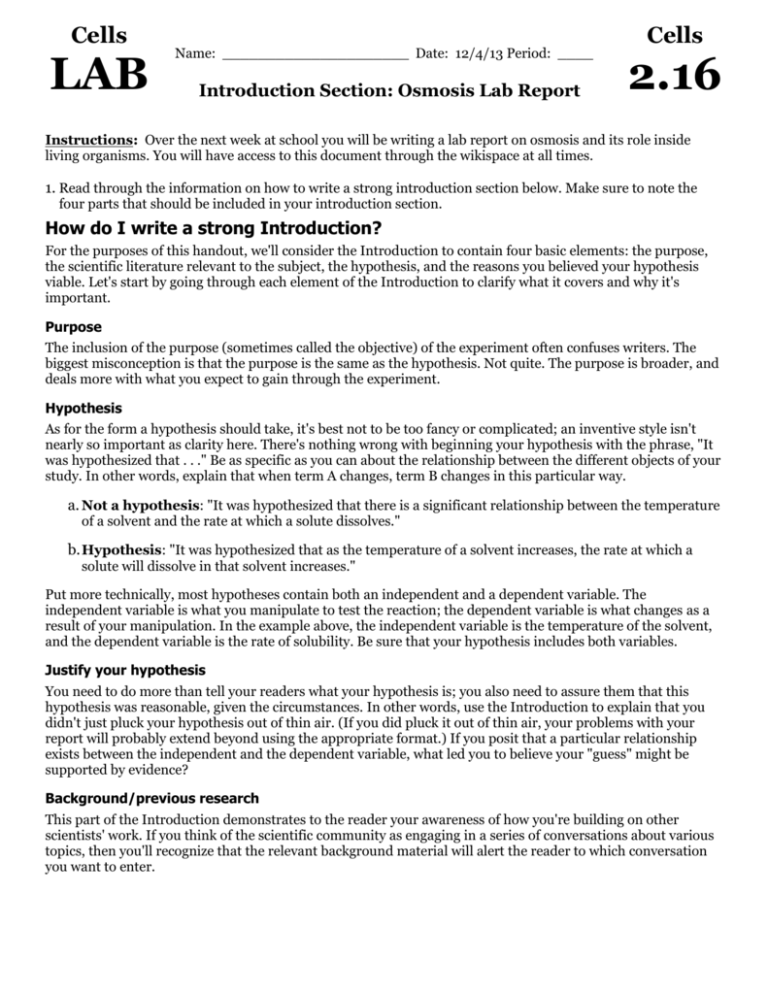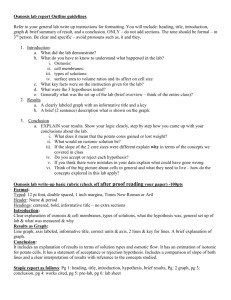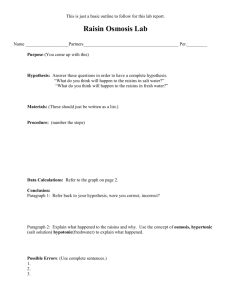OsmosisIntroSection
advertisement

Cells LAB Name: _____________________ Date: 12/4/13 Period: ____ Introduction Section: Osmosis Lab Report Cells 2.16 Instructions: Over the next week at school you will be writing a lab report on osmosis and its role inside living organisms. You will have access to this document through the wikispace at all times. 1. Read through the information on how to write a strong introduction section below. Make sure to note the four parts that should be included in your introduction section. How do I write a strong Introduction? For the purposes of this handout, we'll consider the Introduction to contain four basic elements: the purpose, the scientific literature relevant to the subject, the hypothesis, and the reasons you believed your hypothesis viable. Let's start by going through each element of the Introduction to clarify what it covers and why it's important. Purpose The inclusion of the purpose (sometimes called the objective) of the experiment often confuses writers. The biggest misconception is that the purpose is the same as the hypothesis. Not quite. The purpose is broader, and deals more with what you expect to gain through the experiment. Hypothesis As for the form a hypothesis should take, it's best not to be too fancy or complicated; an inventive style isn't nearly so important as clarity here. There's nothing wrong with beginning your hypothesis with the phrase, "It was hypothesized that . . ." Be as specific as you can about the relationship between the different objects of your study. In other words, explain that when term A changes, term B changes in this particular way. a. Not a hypothesis: "It was hypothesized that there is a significant relationship between the temperature of a solvent and the rate at which a solute dissolves." b. Hypothesis: "It was hypothesized that as the temperature of a solvent increases, the rate at which a solute will dissolve in that solvent increases." Put more technically, most hypotheses contain both an independent and a dependent variable. The independent variable is what you manipulate to test the reaction; the dependent variable is what changes as a result of your manipulation. In the example above, the independent variable is the temperature of the solvent, and the dependent variable is the rate of solubility. Be sure that your hypothesis includes both variables. Justify your hypothesis You need to do more than tell your readers what your hypothesis is; you also need to assure them that this hypothesis was reasonable, given the circumstances. In other words, use the Introduction to explain that you didn't just pluck your hypothesis out of thin air. (If you did pluck it out of thin air, your problems with your report will probably extend beyond using the appropriate format.) If you posit that a particular relationship exists between the independent and the dependent variable, what led you to believe your "guess" might be supported by evidence? Background/previous research This part of the Introduction demonstrates to the reader your awareness of how you're building on other scientists' work. If you think of the scientific community as engaging in a series of conversations about various topics, then you'll recognize that the relevant background material will alert the reader to which conversation you want to enter. Name: _____________________ Date: ___________ Period: ____ 2. Use your lab results, lab handout, and the information below (you can also feel free to use the internet, but if you do so make sure to write down the websites you use) to help you answer the questions at the bottom of this sheet in paragraph form in your own words on a separate sheet of paper. Writing a strong introduction section is difficult, so don’t be frustrated if it takes a while to get going. Some Background Information 3. Use your notes on Osmosis and diffusion from class, or the additional notes provided on the next page. Introduction Questions: 1. What was the purpose of our grape osmosis experiment? Why did we do this experiment? What did we hope to learn/see? 2. What was your group’s hypothesis about how the different liquids would affect the grapes? Why was this your group’s prediction? (make sure you write all three hypotheses!) 3. Explain what is meant by the term homeostasis. Why is it important for a living organism to maintain homeostasis? Give an example of a factor inside the body that is maintained by homeostasis and explain. 4. Explain what is meant by the terms diffusion and osmosis. How do diffusion and osmosis help the body to maintain homeostasis? 5. Give and explain two examples of osmosis and how it may be used by a living organism. 6. Explain what is meant by the terms hypotonic, isotonic, and hypertonic. Explain what would be expected of a cell placed in each type of solution. 7. Some species of saltwater fish return to freshwater to spawn (lay eggs). Explain, in terms of osmosis, what would be expected of a saltwater fish moving to fresh water (would this be a hypertonic, isotonic, or hypotonic solution and what would that mean). Name: _____________________ Date: 12/4/13 Period: ____









